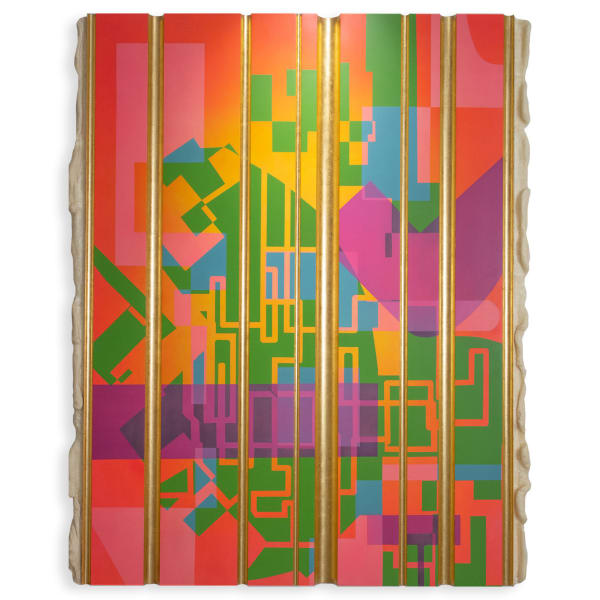Thomas Glassford | The Constant Pull of the Moon
Past exhibition
Installation Views
Overview
Opening Reception: Saturday, July 29, 6-8PM
Quint Gallery is thrilled to present an exhibition of recent work by Thomas Glassford, his first at the gallery since 2017. Glassford’s body of work spans an accumulation of everyday commodities and organic material, translated into mixed-media sculpture and constructions, found object assemblage, and painting. Throughout his career, he has immersed himself in a layered network of references that trace disparate fragments of history, contemporary culture, nature, and tradition. Through different entry points, each work in the exhibition in some way relates to containment - as vessels, channels, or capillaries, whether as articles of cultural significance, urban systems, or extensions of the body.
Objects borne out of nature become a testing ground for the artist, who collects material like acorn tops, coconut shells, palm fronds, and gourds from the surroundings of his Mexico City studio. The forms of gourds and coconut shells are present throughout some artworks in the show, either by direct input or by illusion. In several wall pieces, raw, recessed spheres emerge from imprints of gourds on polyurethane foam or board, contrasted with their highly polished and colorful surfaces. The concept of the vessel has remained throughout Glassford’s practice since the ‘90s, considering the history of the gourd as the first canteen used by civilizations to transport water. The iconography of the gourd dates back to pre-Columbian times when Indigenous civilizations cultivated and utilized them in ritual, medicine, and art, and still holds cultural significance in Mexico today. Along the center of the gallery, a seven-part stone sculpture, made from the off-cuts of stone pilings, is situated on the floor like a canal. Glassford sourced these remnants and assembled them into an aqueduct lined with gold leaf, recalling the remains of the Aztec aqueduct system that brought potable water to Tenochtitlan, now known as Mexico City.
In his most recent series, he explores intuition through geometry. Beginning with stylus drawings on a tablet, Glassford blindly contours 90-degree angles across the surface, uncertain of the outcome until he lifts the stylus and the full image is revealed. These virtual drawings are then translated and precisely cut into three-dimensional objects, developing their own labyrinthine channels which do not necessarily connect. The surfaces are then lacquered, characteristic of Glassford’s vibrant modes of colorization. In Untitled (2023), Glassford combines the channeling, gilding, and mapping of past drawings into one work, resulting in a built up surface of glitched abstraction. In this confluence of approaches, Glassford demonstrates his conceptual relationship to contradiction. Associations reveal themselves through an openness to paradox, towing the line between refinement and vulgarity.
Born in Laredo, Texas, Thomas Glassford earned his BFA at the University of Texas, Austin. He moved to Mexico City in 1990 and joined a young avant-garde group of Mexican, European, and American artists living in the city. Since the early 1990s, Glassford has used everyday materials--ranging from gourds to broomsticks, anodized aluminum to melamine plates--to create architectural or installation-scale works. Glassford’s work is included in numerous public collections including The Museum of Fine Arts, Houston (Houston, Texas); Blanton Museum of Art (Austin, TX); La Colección Jumex (Mexico City, DF); and the Televisa Collection (Mexico City, DF), among others, and participated in the InSITE Biennial editions of 1997 and 2005. In 2010 he designed Xipe Totec, a permanent light installation in Mexico City as part of the 100th anniversary of the country’s National Autonomous University (UNAM), and in 2022, he completed a public mural and sculptural installation at the San Antonio Courthouse through the General Services Administration’s Art in Architecture program. Glassford lives and works in Mexico City.
Selected Works
-
 Thomas Glassford, Variegated Green, 2022
Thomas Glassford, Variegated Green, 2022 -
 Thomas Glassford, Orange Osculum 40, 2019
Thomas Glassford, Orange Osculum 40, 2019 -
 Thomas Glassford, Untitled: 7 Stone Gold Duct, 2023
Thomas Glassford, Untitled: 7 Stone Gold Duct, 2023 -
 Thomas Glassford, Red Osculum 19, 2019
Thomas Glassford, Red Osculum 19, 2019 -
 Thomas Glassford, Luna: Study on the Surface of the Skin, 2021
Thomas Glassford, Luna: Study on the Surface of the Skin, 2021 -
 Thomas Glassford, Untitled: Maps, Gifs, Glyphs and Glitches, 2023
Thomas Glassford, Untitled: Maps, Gifs, Glyphs and Glitches, 2023









